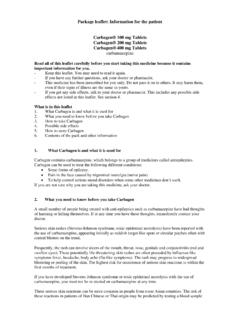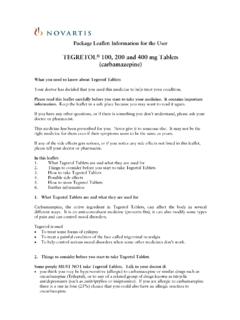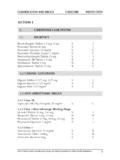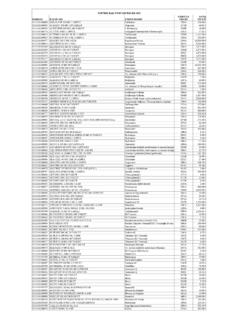Transcription of Hygroton Chlorthalidone 25 mg tablets Presentation
1 Hygroton Chlorthalidone 25 mg tablets Presentation Hygroton 25 mg tablets are speckled pale orange, round, approximately mm diameter, flat tablets with bevelled edges. The tablets are imprinted CW and a scoreline on one side and nothing on the other side. Each tablet contains 25 mg of Chlorthalidone . Uses Actions Pharmacotherapeutic group, ATC Code: Thiazide-type diuretic, C03BA04. Chlorthalidone , the active substance of Hygroton , is a benzothiadiazine (thiazide)-related diuretic, chemically related to the sulphonamides, with a long duration of action. Thiazide and thiazide-like diuretics act primarily on the distal renal tubule (early convoluted part), inhibiting NaCl reabsorption (by antagonising the Na+-Cl- cotransporter) and promoting Ca++ reabsorption (by an unknown mechanism).
2 The enhanced delivery of Na+ and water to the cortical collecting tubule and/or the increased flow rate leads to increased secretion and excretion of K+ and H+. In persons with normal renal function, diuresis is induced after the administration of mg Hygroton . The resulting increase in urinary excretion of sodium and chloride and the less prominent increase in urinary potassium are dose dependent and occur both in normal and in oedematous patients. The diuretic effect sets in after 2-3 hours, reaches its maximum after 4-24 hours, and may persist for 2-3 days. Thiazide-induced diuresis initially leads to decreases in plasma volume, cardiac output, and systemic blood pressure.
3 The renin-angiotensin-aldosterone system may possibly become activated. In hypertensive individuals, Chlorthalidone gently reduces blood pressure. On continued administration, the hypotensive effect is maintained, probably due to the fall in peripheral resistance; cardiac output returns to pre-treatment values, plasma volume remains somewhat reduced and plasma renin activity may be elevated. On chronic administration, the antihypertensive effect of Hygroton is dose dependent between and 50 mg/day. Raising the dose above 50 mg increases metabolic complications and is rarely of therapeutic benefit. As with other diuretics, when Hygroton is given as monotherapy, blood pressure control is achieved in about half of patients with mild to moderate hypertension.
4 In general, elderly and black patients are found to respond well to diuretics given as primary therapy. Randomised clinical trials in the elderly have shown that treatment of hypertension or predominant systolic hypertension in older persons with low-dose thiazide diuretics, including Chlorthalidone , reduces cerebrovascular (stroke), coronary heart and total cardiovascular morbidity and mortality. Combined treatment with other antihypertensives potentiates the blood-pressure- lowering effects. In a large proportion of patients failing to respond adequately to monotherapy, a further decrease in blood pressure can thus be achieved.
5 Because thiazide diuretics including Hygroton reduce Ca++ excretion, they have been used to prevent the formation of recurrent renal calcium oxalate stones. In addition, bone loss in elderly women was reduced. Thiazide diuretics have been found to be useful in nephrogenic diabetes insipidus. The mechanism of action has not been elucidated. Pharmacokinetics Absorption and plasma concentration The bioavailability of an oral dose of 50 mg Hygroton is approximately 64%, peak blood concentrations being attained after 8-12 hours. For doses of 25 and 50 mg, Cmax values average g/mL ( mol/L) and g/mL ( mol/L) respectively. For doses up to 100 mg there is a proportional increase in AUC.
6 On repeated daily doses of 50 mg, mean steady-state blood concentrations of g/mL ( mol/L), measured at the end of the 24-hour dosage interval, are reached after 1-2 weeks. Distribution In blood, only a small fraction of Chlorthalidone is free, due to extensive accumulation in erythrocytes and binding to plasma proteins. Owing to the large degree of high- affinity binding to the carbonic anhydrase of erythrocytes, only some of the total amount of Chlorthalidone in whole blood was found in plasma at steady state during treatment with 50 mg doses. In vitro, plasma protein binding of Chlorthalidone is about 76%, and the major binding protein is albumin.
7 Chlorthalidone crosses the placental barrier and passes into the breast milk. In mothers treated with 50 mg Chlorthalidone daily before and after delivery, Chlorthalidone levels in foetal whole blood are about 15% of those found in maternal blood. Chlorthalidone concentrations in amniotic fluid and in the maternal milk are approximately 4% of the corresponding maternal blood level. Metabolism Metabolism and hepatic excretion into bile constitute a minor pathway of elimination. Within 120 hours, about 70% of the dose is excreted in the urine and in the faeces, mainly in unchanged form. Elimination Chlorthalidone is eliminated from whole blood and plasma with an elimination half-life averaging 50 hours.
8 The elimination half-life is unaltered after chronic administration. The major part of an absorbed dose of Chlorthalidone is excreted by the kidneys, with a mean renal plasma clearance of 60 mL/min. Special patient groups Renal dysfunction does not alter the pharmacokinetics of Chlorthalidone , the rate- limiting factor in the elimination of the drug from blood or plasma being most probably the affinity of the drug to the carbonic anhydrase of erythrocytes. No dosage adjustment is needed in patients with impaired renal function. In elderly patients, the elimination of Chlorthalidone is slower than in healthy young adults, although absorption is the same.
9 Therefore, close medical observation is indicated when treating patients of advanced age with Chlorthalidone . Indications Arterial hypertension, essential or nephrogenic or isolated systolic, as primary therapy or in combination with other antihypertensive agents. Stable, chronic heart failure of mild to moderate degree (New York Heart Association, NHYA: functional class II or III). Oedema of specific origin. Oedema due to peripheral (chronic) venous insufficiency; short-term therapy if physical measures prove insufficient. Fluid retention in premenstrual syndrome only if the gain in weight is the main symptom and is well documented.
10 Ascites due to cirrhosis of the liver in stable patients under close control. Oedema due to nephrotic syndrome. Prophylaxis against recurrent calcium oxalate calculi in patients with idiopathic, normocalcaemic hypercalciuria. Dosage and Administration As with all diuretics, therapy should be initiated with the lowest possible dose. This dose should be titrated according to the individual patient's response to gain maximum therapeutic benefit while keeping side effects to a minimum. A single dose is recommended, either daily or every other day, to be taken in the morning with food. Hypertension The range of clinically useful doses is mg/day. Recommended starting doses are either or 25 mg/day, the latter being sufficient to produce the maximum hypotensive effect in most patients.
















